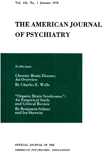Abstract
1. A study was made of the suicidal communications of 87 patients admitted to a short-term care, private psychiatric hospital.
2. There is a high prevalence of suicidal communications (68%) in such patients.
3. There were 16 different ways of communicating suicidal intent. The most frequent ways were statements by the patient that he wanted to die, that he would be better off if he were dead, that his family would be better off if he were dead, and that he intended to commit suicide. Each of these was made by at least one-third of the patients.
4. The use of suicidal communication as [SEE SOURCE PDF TABLE 10.] a taunt or threat was infrequent, occurring in only 7% of patients. The great majority of communications were, therefore, not perceived as a means of manipulating the environment for ulterior reasons, but seemed rather to be expressions of hopelessness and despair.
5. The suicidal communications tended to be varied and repetitive.
6. The preoccupation with suicide was not a "way of life" for these patients. Over two-thirds of those who communicated suicidal ideas had begun talking about suicide only within one year of admission, and almost one-half within only 3 months prior to admission.
7. Patients with manic-depressive disease showed a much higher prevalence of suicidal communications than did patients in the miscellaneous group.
8. There are frequent references in the psychiatric literature that everyone, or almost everyone, has at some time thought of suicide. It is evident from the findings noted in conclusions 6 and 7 that there is a vast difference between these presumably evanescent and transient thoughts of suicide and the suicidal preoccupations that lead to the suicidal communications described in the present study. These communications do not occur in everybody (in fact, in only one-third of the miscellaneous group, even though they were ill enough to be in a psychiatric hospital) and when they do occur, in the majority of instances they have been present for less than a year. It may very well be that thoughts of suicide in the clinically well persons referred to in the literature are clinically meaningless and unrelated to the suicidal communications and to suicide which may occur in psychiatrically ill patients.
9. It is probable that in patients ill enough to be admitted to a psythiatric hospital those with manic-depressive disease and chronic alcoholism account for the vast majority of patients who make any suicidal communication.
10. There was a high rate of agreement, over 80%, between patients and informants concerning suicidal communications. These data were obtained by means of a systematic clinical interview in which each question was asked of each patient and informant, and in which all positive answers were explored in detail. The finding of such a high rate of agreement suggests that it is possible to obtain, by means of a systematic interview, reliable and presumably valid information concerning even such a psychologically sensitive area as suicidal preoccupation.
11. There was one category of suicidal communication–the specific statement of intent to commit suicide–that the patients answered affirmatively less frequently than did the informants. Apparently the patients were reluctant to admit to, or did not remember having made, such a specific statement of suicidal intent, although they readily discussed other concerns with death and suicide.
12. The findings in this study of a high rate of suicidal communication in manic-depressive disease and chronic alcoholism are similar to the findings in a group of completed suicides previously studied. It will next be necessary to study ambulatory patients with these illnesses in order to ascertain the value of suicidal communication as an aid in the prevention of suicide.

